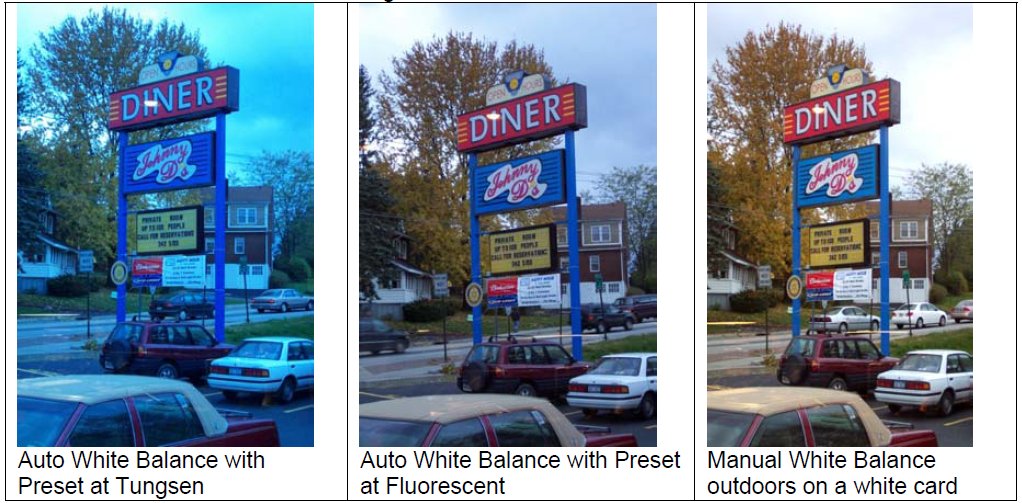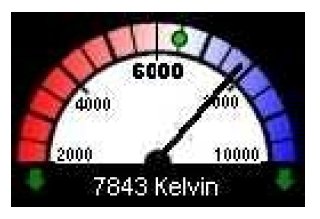by Hal Landen
To control color in video and digital still cameras, a camera function called white balance is used. Many simple video cameras like the Flip camcorder (see our Flip camera review) and point and shoot still cameras have only automatic white balance functions. Without a manual white balance function, these cameras cannot control the colors in the camera.
What is White Balance
White Balance is a function of the camera which electronically adjusts the RGB color mixture. It tells the camera what is “white” and what is not. And that’s what helps us keep our video and digital stills the right color. Lighting can present a wide variety of colors. Video white balance is a very precise way to correct for ordinary light changes as well as some difficult lighting situations such as fluorescent lighting or underwater shooting that are hard to adjust for with lens filters alone. To understand white balance you first need to understand something about color temperature. Take a white sheet of paper into a dark room and light a candle (but not the paper!) You see the white sheet of paper. Now turn on the room lights and you still see the white paper. Take the paper outside in full sun and still you see a white sheet of paper. Same paper, same white, right? Nope, because what your eye sees as white in those different lights is actually a different color of white. You aren’t always aware of this because your eyes have an extraordinary ability to adjust to different lighting. Video does not.
For dramatic proof of this concept, take a video or digital still camera and record the same subject perhaps a friend holding that piece of white paper under all three of the different lighting situations above. Turn on the manual white balance on the camera and white balance just once in normal household light. Keep the same white balance for all three shots. Those three shots will have very different colors.
Below is the same shot taken with three different white balance settings.

As you can see above, how you white balance has a major impact on the look of your shot. Through three different white balance choices the camera was given three different color temperatures as white.
Color temperature measures color in degrees Kelvin or K for short. When you heat a piece of steel until it becomes “red hot”, this will glow at a certain color temperature, somewhere around 3200 degrees K. Heat the steel even hotter and it changes color again to a “white hot” which is probably around 5000 degrees K. Hotter still and it becomes blue white which is around 5500 – 6000 degrees K or Kelvin. This is a very important concept to photographers, filmmakers and video shooters.
Film (as opposed to video) is rated by Color Temperature. You can buy Tungsten film for shooting under Tungsten lights or you can buy Daylight film for shooting under daylight. If you are shooting film, an excellent guide for working with color temperature is at
http://wwwca.kodak.com/CA/en/consumer/guideToBetterPictures/eStores/index.jhtml?style=&cat=3
Below is a very useful chart that will give you a good head start on understanding color temperature and white balance. While this chart is intended for use with motion picture film, the color temperature of the sources listed do not change whether you are recording on digital video or on motion picture film. This chart is excerpted from:
Cinematographer’s Field Guide
KODAK MOTION PICTURE CAMERA FILMS
Approximate Correlated Color Temperature for Various Light Sources
Source Degrees Kelvin
Artificial Light
Match Flame . . . . . . . . . . . . . . . . . .. . . . . . . . . . . . 1700
Candle Flame . . . . . . . . . . . . . . . . . . . . . . . . . . . . . 1850
40-Watt Incandescent Tungsten Lamp . . . . . . . . . . . . . . . . . . 2650
75-Watt Incandescent Tungsten Lamp . . . . . . . . . . . . . . . . . . 2820
100-Watt Incandescent Tungsten Lamp. . . . . . . . . . . . . . . . . . 2865
500-Watt Incandescent Tungsten Lamp. . . . . . . . . . . . . . . . . . 2960
200-Watt Incandescent Tungsten Lamp. . . . . . . . . . . . . . . . . . 2980
1000-Watt Incandescent Tungsten Lamp . . . . . . . . . . . . . . . . . 2990
3200-Degree Kelvin Tungsten Lamp . . . . . . . . . . . . . . . . . . . . 3200
C.P. (Color Photography) Studio Tungsten Lamp. . . . . . . . . . . 3350
Photoflood and Reflector Flood Lamp . . . . . . . . . . . . . . . . . . . 3400
Daylight Blue Photoflood Lamp . . . . . . . . .. . . . . . . . . .. . . . . . 4800
White Flame Carbon Arc Lamp . . . . . . . . . .. . . . . . . . . . . . . . . 5000
High-Intensity Sun Arc Lamp . . . . . . . . . .. . . . . . . . . . . . . . 5500
Xenon Arc Lamp . . . . . . . . . . . . . . . . . . . . . . . . . . . . . . . . 6420
Daylight
Sunlight: Sunrise or Sunset . . . . . . . . . .. . . . . . . . . . . 2000
Sunlight: One Hour After Sunrise . . . . . . . . . . . . . . . . . 3500
Sunlight: Early Morning . . . . . . . . . . . .. . . . . . . . . . . . 4300
Sunlight: Late Afternoon . . . . . . . . . . . . . . . . . . . . . . . 4300
Average Summer Sunlight at Noon (Washington, D.C.) .. 5400
Direct Mid-Summer Sunlight . . . . . . . . . . . . . . . . . . .. . 5800
Overcast Sky. . . . . . . . . . . . . . . . . . . . . . . . . . . . . . 6000
Average Summer Sunlight (plus blue skylight). .. . . . . . . 6500
Light Summer Shade . . . . . . . . . . . . . . . . . . . . . . . . . 7100
Average Summer Shade . . . . . . . . . . . . . . . . . . . . . . . 8000
Summer Skylight Will Vary from . . . . . . . . . . . . . . . . . 9500 to 30,000
NOTE: Sunlight is the light of the sun only. Daylight is a combination of sunlight plus skylight. The values given are approximate because many factors affect color temperature.
OUTDOORS: the sun angle, and the conditions of the sky- clouds, haze, dust particles-raise or lower the color temperature.
INDOORS: lamp age (and blackening), voltage, type of reflectors and diffusers affect tungsten bulbs-all of these can influence the actual color temperature of the light. Usually a change of 1 volt equals 10 degrees Kelvin. But this is true only within a limited voltage range and does not always apply to “booster voltage” operation, since certain bulbs will not exceed a certain color temperature regardless of the increase in voltage.

How To Work With Different Color Temperatures
Color temperatures are often referred to as cool or warm like a “warm Incandescent tungsten lamp” or a “cool outdoor shade.” While there are Color Temperature meters for taking precise color temperature readings of a particular light source, in video production this is most often done by experience and knowledge of just a few color temperatures from the chart above. And it is fairly straightforward. Most movie lights are provided in the standard 3200 degrees Kelvin. And on most cameras the White Balance switch has a “Preset” position of 3200 degrees K, or as many auto cameras and camcorders call it “Tungsten” or “Indoor.” That makes it very simple. Just flip the switch to 3200K or Indoor and shoot.
This assumes all the light falling on your subject is 3200K. When you are working in a room lit by household lights, the lighting is probably not exactly 3200K. In most cases it is less, so to be accurate it is wise to manually white balance before shooting in these conditions. In a sense any camera with a manual white balance has its own color temperature meter. While this meter does not give a reading in degrees Kelvin like the one above, it does read the color temperature and adjust the camera so that white will be the white you would expect.
So far it’s all pretty simple. You can choose a preset white balance or simply perform manual white balance under the primary source of light.
But it can get a lot more complicated. Consider the lighting in a theater. Stage lights are usually a combination of different colored lights and they are usually on dimmers. Dimming an incandescent light changes its color temperature to a warmer value. The large spot lights used in theaters are very different than the typical stage and overhead lights. These spots tend to be quite blue, close to a cool daylight, but it’s dangerous to assume you know the color temperature of any light.
Ideally you would work with the theater’s lighting technician before you need to shoot. You could perform a couple manual white balances and have your camera memorize these whites by using the white balance memory switches found in professional cameras. Of course you would not want to change or “correct” colored lights to white when a colored effect was the original intention.
Just as color temperatures on a stage will vary quite a bit, indoor lighting in the real world is often from mixed sources such as window light, incandescent lights and fluorescent lights. These all have very different color characteristics and color temperatures. If you were shooting art work or paintings and wanted to reproduce the colors accurately, you would want one consistent color temperature of light. In this case the simplest strategy is to make one type and color of light be the dominant light on the subject and white balance on that dominant light.
If you were shooting an interview, you can allow different color temperatures to fall on different surfaces. Typically you would white balance on the key light that is the primary light for your subject. Behind or to the side of the subject you might allow some daylight from a window to
illuminate a background surface. This is an artistic choice you control. Daylight, however, can change in a heartbeat and give you some real editing headaches when the background suddenly becomes a different color and intensity. Many D.P.’s would recreate that kind of daylight with a
movie light. They cover the light with a blue gel such as Tough Blue 50 which makes the resulting light appear to be blue daylight.
For more information see The Art of Shooting the Video Interview: A Moving Portrait By Bill Farnsworth at http://www.videouniversity.com/articles/the-art-of-shooting-the-video-interview-a-moving-portrait






Recent Comments